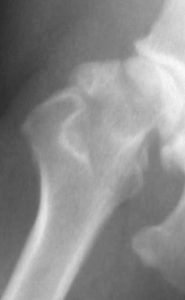Total hip replacement (THR) involves replacing both the ball (head of the femur) and socket (acetabulum) of the hip joint with implants. These new components are designed to interact and function in the same manner as a “normal” hip joint.
Which Dogs are Good Candidates for a Total Hip Replacement?
Many factors must be evaluated to determine if your dog would benefit from a THR. To decide what is best for your dog, the surgeon will:
- Review your dog’s history
- Perform a physical/orthopedic examination
- Evaluate radiographs (X-rays) in order to document abnormalities present in the hip joint
- Interpret laboratory data to confirm your dog’s general overall health and readiness for surgery
A painful hip that is affecting your dog’s comfort and mobility is the primary indication for a THR. Rear limb stiffness and lameness, difficulties rising from a sitting position and climbing stairs and reluctance to exercise are often the first signs that suggest your dog may have a hip problem that requires treatment. Total hip replacement can be performed in any dog large enough to accept the implant (usually > 8 lbs.), and those who are near or at skeletal maturity (finished growing). In most dogs, 9 months of age is the earliest the THR procedure can be done.

Radiograph (x-ray) showing arthritis in a dog that would benefit from Canine Total Hip Replacement.
Is my Dog Too Old to Have a THR?
There is no upper age limit for the procedure as long as your dog is otherwise in good overall health. Healthy older dogs have the same prognosis as young dogs, however we recommend that owners consider additional diagnostic tests for dogs older than 7 years of age prior to a THR. In addition to complete blood work (CBC and biochemistry profile), an abdominal ultrasound and thoracic radiographs are recommended. These important, but optional, tests are intended to rule out “silent” but potentially significant diseases that may negatively impact outcomes following major surgery.
What is Expected following Total Hip Replacement Surgery?
The goal of THR is to provide a pain-free and mechanically sound hip, with the majority of dogs having a significantly improved quality of life, including:
- Increase in muscle mass
- Improved comfortable hip range of motion
- Increased activity levels and endurance
- Markedly improved general mobility and energy levels
Should I Stop Giving My Dog’s Medications Before Surgery?
- Medications for health conditions such as diabetes or low thyroid function should not be stopped.
- Medications for hip pain can be continued up until surgery.
- Oral steroids should ideally be stopped one week prior to the surgery.
Is Surgery Performed the Day of My First Appointment?
No. Your dog must be screened before surgery which involves taking a complete history and a performing a physical/orthopedic examination. If the preoperative evaluations reveal no other abnormalities, your dog’s surgery will then be scheduled for another day. Additional hip X-rays are typically taken at the time of your dog’s THR surgery in order to measure them for their implants.
How Long Will My Dog be Hospitalized After Surgery?
The routine length of hospitalization following THR surgery is overnight.
What is the Success Rate of Total Hip Replacement Surgery in Dogs?
Over 90% of dogs experience dramatic improvements in their overall function after THR. While the prognosis is typically excellent following THR, peak recovery (progressive resolution of lameness, muscle development, etc.) is generally not achieved until 4-6 months postoperatively.
My Dog has 2 Bad Hips. What’s the Chance the Other Side Will Also Require a THR?
Only 20% of dogs that have bilateral hips disease require both hips to be replaced in their lifetime. If indicated for the unoperated hip, multimodal medical management of osteoarthritis can be considered.
What are the Potential Complications Associated With THR?
As with any surgery, THRs have their own set of potential complications. All surgeries carry some risk of unsuccessful outcomes, complications, injury or even death, from both known and unforeseen causes. The most described
THR complications include:
- Hip joint dislocation
- Incision-related issues
- Surgical site infections (short and long-term)
- Loosening of the implants over time
- Sciatic nerve injury
- Femur (thigh bone) fracture during and after implantation
While the occurrence of THR complications are the exception, they will be thoroughly reviewed during the consultation. At MedVet, we have board-certified anesthesiologists who oversee anesthesia in all patients undergoing surgery which helps to ensure it is as safe and comfortable as possible for your pet.
What is the Postoperative Care for my Dog after Total Hip Replacement?
The postoperative care for your dog is critical following a THR. Activity levels must be strictly controlled for the first month after surgery:
- Your dog should only be let out on a leash to urinate or defecate.
- Your pet should avoid stairs or slippery floors.
- Your dog should not run, jump or play for the first two months after surgery.
- When your dog is not under your direct control, they should be kept confined to a small area, cage or crate.
- Limited leash-based activities are allowed to encourage immediate limb use following THR.
All written postoperative care will be discussed and demonstrated for you at the time of your dog’s discharge from MedVet.

